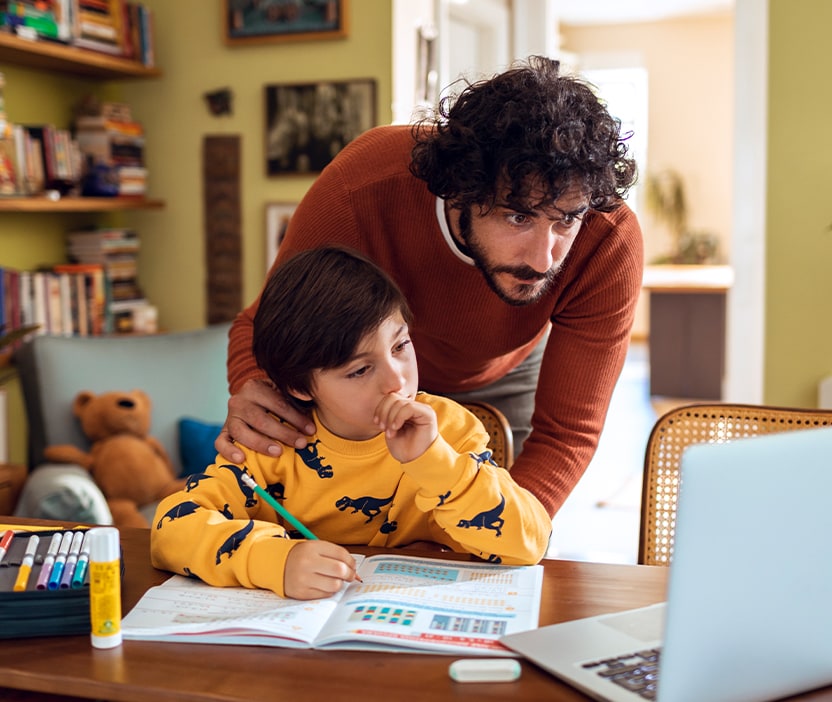Pop quiz—Prepare your kids to be Cyber Safe this school year
As your kids are speeding back to school, what’s the plan to help them stay Cyber Safe? Check out this short quiz to help get your kids ready for any online safety challenges.

When the leaves on the trees begin to turn and local coffee shops start rolling out pumpkin-spice... everything, it heralds that our kids are returning to the classroom. And their connected smartphones, tablets, and computers are going with them.
Whether children are heading back to the classroom or attending remotely, there are online risks out there that they—and you—can learn to avoid. With the latest threats and technologies evolving, now is a great time to offer a quiz for keeping kids safe from digital threats.
Grab a pencil to keep score, and let’s get started!
1. Which of the following are dangers your child could face online?
A. Identity theft
B. Malware
C. Inappropriate content
D. AI-generated deepfakes
E. All of the above
It’s unfortunate but true that all these things (E) are hazards your children can encounter online. Young people are particularly vulnerable to identity theft and malware, and it’s a good idea to talk them through making safe decisions about what content they should and shouldn’t interact with when they’re browsing the internet.
2. When kids go back to school, cybercriminals are already at work. Which of the following is NOT a way to help make their return to class Cyber Safe?
A. Have a talk with your kids about the importance of privacy and Cyber Safety.
B. Install Norton VPN on your kids’ devices and teach them how to use it.
C. Ask your cousin to look at your kids’ smartphone to be sure it’s all ok.
D. Consider installing parental controls on your kids’ device.
E. Enable multi-factor authentication on all accounts.
Your cousin may be tech-savvy, but it may not be enough to make sure your kids are protected online. However, having a conversation with your kids about protecting themselves, teaching them how to use a strong and reliable VPN, adding Parental Controls, and enabling multi-factor authentication are all good steps to help keep them safe.
3. Money : Bank :: Email Login :
A. 3-Ring binder
B. Password management program
C. Yellow sticky-note
D. VPN
One of the best ways to protect your money is to put it in the bank. Likewise, your kids (and you for that matter) can get the best kind of email and password protection by using a password manager. Using a tool like this one allows you to create and quickly retrieve strong, unique passwords for every account you own. Teach kids to use them early and empower them with great security habits.
4. Your child can legally have an account on most social media sites once they’re in which grade?
A. 6th
B. 7th
C. 8th
D. 9th
Among the social platforms, WhatsApp is the outlier, has the highest minimum age of all the social networks, requiring anyone signing up for an account to be 16 years of age. For Facebook, X (Twitter), TikTok, SnapChat, and Instagram, users must be at least 13 years old, putting them in 7th or 8th grade.
But, there are two caveats: First, all anyone needs to sign up for a social media account is an email address and enough math skills to falsify their birthdate. Second, just because your child is old enough to legally be on social media doesn’t mean they have to be. Talk with them about the risks, how to manage their content, and how to stay safe while enjoying being online.
5. Which of the following are the healthy benefits of adding parental controls to your kid’s device:
A. Setting up school hours so their device can only access sites they need for schoolwork.
B. Adding geo-tracking so you can always locate them.
C. Monitor the websites, videos, and apps they visit and block harmful sites when needed.
D. Discover search terms from their devices to find out more about their interests.
E. All of the above
All of the above are all great benefits. Parental Controls allow you to set up as few or as many of these features as you see fit. Having conversations with your kids about staying safe online and teaching them the discipline to limit online hours can set them up early for a lifetime of good online habits.
6. Which of the following is a real problem your child could face in the digital classroom?
A. “Malware ate my homework.” (Malware is not their pet’s name.)
B. “My teacher’s Facebook account is locked so we don’t have class today.”
C. “Superhackers have taken over my classroom and all we can see is TikTok.”
D. “The principal says I need a computer with a better GPU for my games.”
The answer is A. Malware is a real hazard for your child’s device and any device under your roof. Pushing back against malware that can corrupt your files or hold your data ransom is what Norton has focused on for decades. Adding award-winning device security to your child’s laptops and smartphones is an excellent extra layer of protection when you send them back to school.
So how did you do? 6 out of 6? Not bad!
Remember that one of the best ways to foster great security habits with your kids is to keep them informed and aware as they mature both in real life and online.
To get more information about risks and good online habits for young people of any age, visit our Kid’s Safety page that’s continually updated with the latest information for parents and kids alike.
Editorial note: Our articles provide educational information for you. Our offerings may not cover or protect against every type of crime, fraud, or threat we write about. Our goal is to increase awareness about Cyber Safety. Please review complete Terms during enrollment or setup. Remember that no one can prevent all identity theft or cybercrime, and that LifeLock does not monitor all transactions at all businesses. The Norton and LifeLock brands are part of Gen Digital Inc.





Want more?
Follow us for all the latest news, tips, and updates.